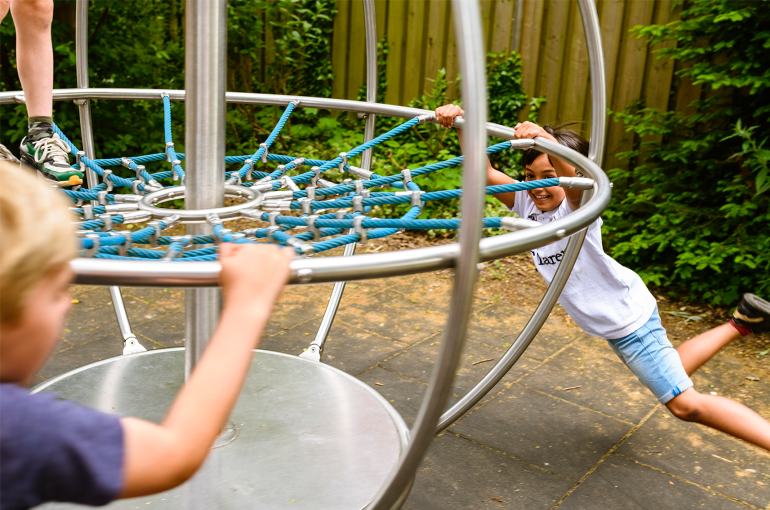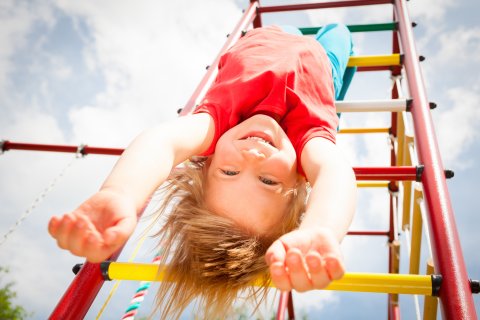"Get rid of those rubber schoolyard tiles"

Anxious adults. Restrictive regulations. Dull playgrounds. It makes children do less and less 'risky play'. And that is a shame, say Utrecht researchers Kirsten Visser (UU) and Heidi Lesscher (UU). Because it is precisely through adventurous play - climbing trees, roaming the neighborhood - that children develop things like social behaviour, self-confidence, and perseverance. "But fortunately 'risky play' is being rediscovered."
We make it increasingly difficult for children to play adventurously, threatening to miss some important steps in their development
A key year, researchers say, is 1998. That was when new legislation on playground equipment was introduced, and rubber tiles appeared everywhere in schoolyards and playgrounds under the climbing frame, seesaw and slide.
"Don't get us wrong, of course we don't want your child to be seriously hurt or in danger. But a trend did start around the turn of the century that makes it increasingly difficult for children to play adventurously, threatening to miss some important steps in their development," say Kirsten Visser, lecturer, and researcher in Urban Geography (UU) and Heidi Lesscher, neurobiologist and senior lecturer (UU).
Cage full of challenges

As a neurobiologist, Heidi researches rat behaviour, which is to some extent similar to that of humans. "We create two groups. One group lives in a relatively boring cage where there is little to do and they can only play socially. The second group gets to play every day in a cage where they have challenges, such as climbing high and having to make choices. You can see in the latter group that the front part of the brain is better developed and that these animals are cognitively stronger. Animals that cannot play at all (even with peers), on the contrary, develop emotional, social and cognitive problems and have trouble making decisions." As an urban geographer, Kirsten has conducted research in two playgrounds in Rotterdam, which have been set up to encourage risky play. She investigates how these places are used by children and maps the views and experiences of children, parents, and policymakers.
Animals that cannot play at all, develop emotional, social and cognitive problems and have trouble making decisions
Dirty shoes
They recount how parents and carers have become increasingly anxious, cautious, and perhaps lazy over the past decades. Whether at home, in their own neighborhood, at the BSO or in the schoolyard, play is often controlled to perfection. Fear rules. At daycare, carers apologise to parents that the child's shoes got dirty.
Kirsten: "Children can play less and less freely. Playing increasingly takes place under parental supervision or in controlled environments such as managed playgrounds. And where you used to be able to play on construction sites as a child, this is now also impossible. Construction sites are literally boarded up."
Children can play less and less freely

Research was conducted on how three successive generations moved through the neighborhood. The grandparents' generation was allowed to do so freely, without restrictions. The parents' generation had to enter when the lampposts came on - that was already a somewhat smaller area. Today's generation is barely allowed out of the street and has to stay in sight.
Romp
But what exactly is 'risky play' or adventure play? Researchers define it as playing at height, at high speed, with dangerous objects and out of sight of adults - in the bushes or a few streets away. It is exciting, and exhilarating and comes with the risk of injury (not serious).
By playing risky, you grow up healthy
"It is something that children do naturally. The romping and frolicking that used to just belong there," says Heidi. "Playing is part of our nature. It is a very powerful rewarder. And that is precisely why children learn so much through play. If there is a disturbance in play, you find a solution together to continue playing. You learn social behaviour, dealing with disappointment, the ability to adapt. If you fall, you also learn how to fall better next time. It is, in short, good for your self-confidence and perseverance. By playing risky, you grow up healthy."
"Children who play less adventurously suffer from more fears and have accidents faster. Precisely because they have less experience, they fall out of that tree, so to speak, faster. And they fall wrong," Kirsten adds.
Real play
The conversation turns to whether the provision of electronics such as computers and smartphones affects the extent to which children play outside. "The fact that parents are so protective and risk-averse probably does have to do with the media and how it creates fear images of the outside world. But to speak of a causal link, more research needs to be done," says Kirsten.
Heidi: "If you ask children between the ages of 8 and 12 what they mean by really playing, they all mention: playing outside. That is interesting. There is an internal conflict there. So they really do want to."
"Yes," says Kirsten, "parents say the same thing. They reminisce about the old days when you really played outside. That awareness is there. But still they find it hard to let go of their children more. We want to do more research on that too."
Consciousness

Is there a way out of this impasse? For example, should there be policies that better enable adventure playgrounds? That can help, and there are education programmes here and there, say Heidi and Kirsten. "But the key really lies with the parents. They let the children out and then must dare to let them loose there. We need to recognise the hindering and stimulating factors among parents and come up with new solutions together with them. For instance, involve them in designing play areas."
But then let it go, they implore. Also, don't confuse adventurous play with club-based play. The degree of organisation should be minimal. It is about free play, and the essence is that the children should be able to fill it in themselves.
After 25 years of regulation, Kirsten and Heidi see that 'risky play' is being somewhat rediscovered. Particularly among municipalities, a broader view is emerging and not everything has to focus on maximum safety anymore. Heidi: "But it is still important to provide more evidence of the importance of adventure play through research. Awareness of this needs to grow much further and we hope we will contribute to that."

